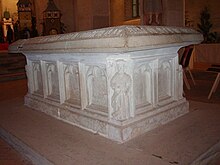Friedrich I. (Swabia)

Friedrich I (* around 1050 ; † 1105 before July 21) from the Staufer dynasty had been Duke of Swabia since 1079 . His father was Friedrich "von Büren" (the nickname is not contemporary), his mother Hildegard von Egisheim - Dagsburg , daughter of Count Gerhard I. During his reign the Staufers rose to the ducal family in Swabia. Together with Peter von Lützelburg, he is considered the founder of the Sankt Walburga monastery . They were supported by his brother, Bishop Otto of Strasbourg .
Life
Presumably Frederick held the dignity of count before the ascension to duke . As a count, Friedrich I began to expand the Hohenstaufen power. He had a castle built on the summit of the Hohenstaufen mountain , which became the ancestral seat and the name giver for the family. A castle near Lorch (Württemberg) was converted into a Benedictine monastery ( Lorch Monastery ) around 1100 , which from this point on served as the house monastery of the Staufer.
However, the family's household goods seem to have been small at that time. Presumably it was limited to the Stauferland around the Hohenstaufen as well as to the possessions acquired by Hildegard in Alsace: in and around Schlettstadt with the Hohkönigsburg and near Hagenau .
The decisive event in Friedrich's lifetime was the transfer of the ducal dignity in Swabia at Easter 1079 in Regensburg . During a noble uprising against the Henry IV. Renegade Rudolf of Rheinfelden included the Staufer the royalist minority. At the beginning of 1079 Rudolf's son Berthold von Rheinfelden was elected Duke of Swabia by the aristocratic opposition. In return, Heinrich gave the title to Friedrich I at Easter and engaged his daughter Agnes to him on March 24, also in Regensburg (the marriage was concluded in 1086 or 1087). In the following years, neither of the two dukes could prevail. After Heinrich had reconciled with Berthold von Zähringen , Rudolf von Rheinfelden's successor, in 1097, the split in Swabia continued. Friedrich could only actually exercise his office in the north of Swabia.
He operated the expansion of the Hohenstaufen domestic power mainly to the north. In the last years of his reign in the Palatinate , he became an important regional power factor through the upper bailiwick of the Weissenburg monastery and the Speyer monastery . This brought the Staufer territory closer to the Salic goods in Rhine Franconia . In the south, Friedrich only brought significant property under his control around Ulm , on the other side of the Danube only isolated free float.
During Henry IV's march to Italy and the associated absence of the ruler from the northern part of the empire, Frederick was the highest military leader on the imperial side.


After his death in 1105 he was buried in the collegiate church in Lorch , the Romanesque predecessor of today's Evangelical City Church. After completion of the monastery church in the Lorch monastery he founded , he was taken over by his son Konrad III around 1140 . reburied there. Abbot Nikolas Schenk von Arberg had all the Staufer graves in the nave, in front of the steps of the choir and in the choir opened in 1475 and the remains were brought together in a tumba in the nave of the monastery church.
His wife Agnes married the second time in 1106, later canonized Leopold III from Babenberg . and was buried with him in Klosterneuburg Abbey near Vienna.
progeny
In addition to the two sons of Duke Friedrich II of Swabia and the later Roman-German King Konrad III. there is evidence of a daughter Gertrud who married Hermann von Stahleck . Information about other children that Hansmartin Decker-Hauff made on the basis of forged Lorcher sources have proven to be products of the imagination.
literature
- Frederick I (1079-1105). The first Duke of Swabia. Editor Karl-Heinz Rueß (Writings on Staufer History and Art. Vol. 26.), Göppingen 2007.
- Thomas Zotz : in: Meinrad Schaab , Hansmartin Schwarzmaier (ed.) U. a .: Handbook of Baden-Württemberg History . Volume 1: General History. Part 1: From prehistoric times to the end of the Hohenstaufen. Edited on behalf of the Commission for Historical Regional Studies in Baden-Württemberg . Klett-Cotta, Stuttgart 2001, ISBN 3-608-91465-X , p. 429 ff.
- Alfons Zettler : History of the Duchy of Swabia, Stuttgart 2003, p. 177 ff.
- Paul Friedrich von Stälin : Friedrich I. (von Hohenstaufen) . In: Allgemeine Deutsche Biographie (ADB). Volume 8, Duncker & Humblot, Leipzig 1878, p. 31.
- Hansmartin Schwarzmaier : Friedrich I, Duke of Swabia (around 1050–1105) . In: Lexicon of the Middle Ages (LexMA). Volume 4, Artemis & Winkler, Munich / Zurich 1989, ISBN 3-7608-8904-2 , Sp. 958 f.
- Hansmartin Schwarzmaier: Friedrich I .. In: New German Biography (NDB). Volume 5, Duncker & Humblot, Berlin 1961, ISBN 3-428-00186-9 , p. 588 f. ( Digitized version ).
Remarks
- ^ Peter Koblank: Staufer graves. Only a few of the most prominent Hohenstaufen are buried in Germany. on stauferstelen.net. Retrieved July 13, 2014.
- ^ Klaus Graf : Staufer traditions from Lorch Abbey. In: Sönke Lorenz u. a. (Ed.): From Swabia to Jerusalem. Facets of Hohenstaufen history. Sigmaringen 1995, pp. 209-240; Tobias Weller : On the way to the “Hohenstaufen house”. On the descent, relationship and connubium of the early Hohenstaufen. In: Hubertus Seibert, Jürgen Dendorfer (Ed.): Counts, dukes, kings. The rise of the Hohenstaufen and the empire (1079–1152). Ostfildern 2005, pp. 41–63, here pp. 56–63.
| predecessor | Office | successor |
|---|---|---|
| Rudolf |
Duke of Swabia 1079–1105 |
Friedrich II. |
| personal data | |
|---|---|
| SURNAME | Friedrich I. |
| ALTERNATIVE NAMES | Duke Friedrich I of Swabia |
| BRIEF DESCRIPTION | Duke of Swabia |
| DATE OF BIRTH | around 1050 |
| DATE OF DEATH | 1105 |